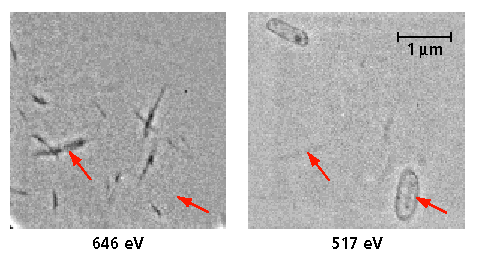
High-Resolution X-Ray Images of Manganese-Eating Microbes
Cleaning up the environment is a monumental task, now consuming many billions of dollars annually. A new field of study, molecular environmental science, is emerging to contribute to effective waste remediation by investigating the routes contaminants take to their final destinations in the environment. These routes include formation of new compounds via interaction with their surroundings, transport through soils and groundwater, uptake in plant and animal life, and possible immobilization in benign forms. Bacteria, it turns out, are potentially key agents with the ability to purify contaminated soils and water supplies. Using the XM-1 microscope at Beamline 6.1.2, researchers have produced high-resolution images of bacteria and mineral particles in water, a key step toward investigating such bacterial bioremediation.

Depending on their species, various bacteria can either oxidize metals dissolved in water, thereby causing the formation of metal-oxide particles, or reduce the metal in solid particles, thereby causing it to dissolve. The solubility of a contaminant affects its transport through the environment.
The x-ray microscope images above were taken in the same area of a sample, (left) at x-ray wavelengths (photon energies) absorbed by the manganese atoms in needle-shaped particles of manganite (MnOOH), and (right) at wavelengths absorbed by the carbon atoms in bacteria. The two arrows in each image show the locations of a manganite needle and a bacterium.
This work was conducted by B.P. Tonner (principal investigator) and K. Nealson (University of Wisconsin-Milwaukee), and W. Meyer-Ilse and J. Brown (Berkeley Lab's Center for X-Ray Optics), using the XM-1 microscope at Beamline 6.1.2.
Funding: Office of Biological and Environmental Research of the U.S. Department of Energy, Laboratory for Surface Science and Center for Great Lakes Studies (University of Wisconsin-Milwaukee), and Office of Basic Energy Sciences of the U.S. Department of Energy.
ALSNews article about this science highlight
More ALS Science